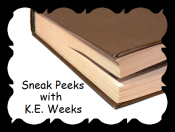 |
| This feature is presented by guest blogger, K.E.Weeks. |

The book is truly an example of where less is more, where what is left unsaid is more powerful than what is said. The poems speak in vignettes, such as this one after six-year-old Syvia’s friend Hava disappears while out for a walk:
Itka comes over to my apartment,Overall, Yellow Star is a gentle introduction to the Jewish Holocaust. While there is talk of hunger, starvation, beatings, “the trains,” and death, the adults in the story attempt to shield Syvia from the worst of the experience, which means the reader is spared much of the raw violence and anguish as well. At the beginning of each section, two pages from the narrator’s perspective describe the historical setting and the events surrounding this portion of the narrative.
but we don’t say much.
Our dolls do the talking for us.
Itka’s doll: Where is our friend today?
My doll: I don’t know.
Itka’s doll: Perhaps she had another engagement.
My doll: More important than our weekly tea? (Roy 39)
I recommend this book for upper elementary, middle schoolers, and youthful high schoolers. It is a quick read—even at 230 pages, I read it in a few hours. I give it four stars (out of five) for its Hemingway-esque brevity; insightful, child perspective; and historical accuracy.
Disclaimer: The purpose of this review is to guide parents into selecting appropriate, significant, high-quality literature for their teens and tweens. I have no connection with the author or publisher of this book. I am a home educator of two children, 12 and 15, with a Master of Art degree in American Literature and a keen interest in young adult fiction and nonfiction.
*Contains affiliate links